
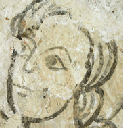
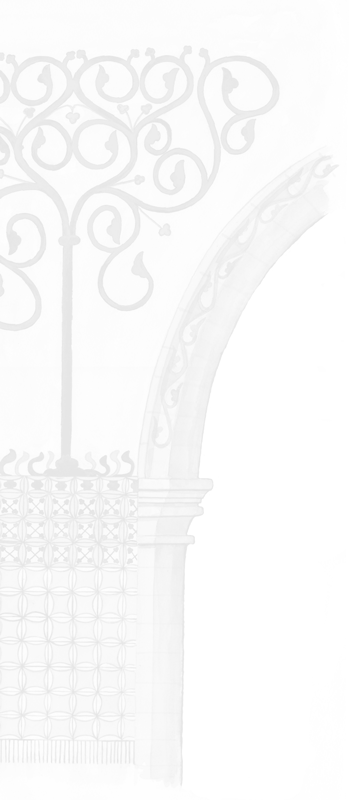
Friday 27th February—The third of our lunchtime lectures was very well attended with nearly thirty people turning out on another chilly day to come and see the progress that is being made. We are now at the end of the third week of the project and a number of exciting things have come to light. Once again we had lots of questions, particularly about the conservation techniques being used, and the last of the visitors left over two hours after the talk began. We had also set up a couple of laptop computers that ran slideshows of images taken from the top of the scaffold. Finally people were able to get a close look at some of the scenes that are so difficult to see from the ground. We are expecting a big turn out for next weeks final lecture.
Saturday 28th February—We played host to Clive Paine’s adult study class today and were pleased to welcome more than twenty of them to the church. The class often make field trips out to historic churches and they had many interesting observations to make on both the fabric and decoration of the church. It is hoped that they will be making a return visit when the scaffold is taken down and the paintings can be seen in all their glory.
Where is the Virgin? - ever since starting the project we have been wondering exactly where the Virgin Mary is at St Mary’s. Medieval images of the Virgin feature regularly in medieval decoration and we anticipated finding at least some reference in the decoration at Lakenheath. However, as far as we could see she wasn’t here.
However, on Friday afternoon Mark Perry was cleaning the lower section of the main pillar in the north arcade and made an amazing discovery. The virgin had been staring us in the face since the very beginning. However, she was so badly damaged that we just didn’t see her. In fact, when we looked closely we realised that we had a full figure of the enthroned Virgin, with the Christ child upon her knee, and St Edmund kneeling or sitting at her side. A very unusual configuration indeed.
Tuesday 3rd March—The project enters its fourth week and the work is now heavily concentrated on the north arcade—in particular, the main arcade pier upon which St Edmund sits. Bianca is working on the high scaffold, cleaning and fixing the scenes from our Passion cycle. Below her Mark is cleaning and fixing the scene that we now believe shows the enthroned Virgin and Child. As each day passes we can make more sense of what we are seeing as new details emerge from beneath over a centuries worth of dust and grime. Nearby Doug is now hard at work cleaning the surface of the scrollwork and dot pattern that lines the arches of the arcade. Despite being painted directly onto the stone the cleaning process has really helped us make a lot more sense of this scheme.
With only a few days to go before the last of our public talks we are trying to finally make sense of some of the more puzzling aspects of some of the schemes. With this in mind we have sent a number of images to David Park at the Courtauld Institute, one of the country’s leading experts on medieval wall paintings, in the hope that he will be able to help with the dating of the various schemes. In addition, we are expecting a visit from Roger Rosewell, the author of Medieval Wall Paintings, in the next few days. Hopefully, we should soon have much clearer ideas about the dating of the individual schemes.
News—The image of St Edmund from Lakenheath features as ‘Picture of the month’ on the medieval wall paintings website— www.wallpaintings.org
Friday 6th March—We held the last of our lunchtime talks today and were overwhelmed with the response. Over fifty members of the public attended and we had a great deal of positive feedback. We were also pleased to welcome Clive Paine back on site and are all very interested in his observations on the fabric of the building. We were also pleased to have a number of people from the nearby parish of Troston—whose project to conserve their own medieval wall paintings begins shortly.
Saturday 7th March—We are beginning to notice that the decoration beneath the arcade arches is a great deal more complex than we first thought. Doug has spent the week working on the pillars and arches and everything is becoming much clearer. The scrollwork and dot pattern, thought to be contemporary with the first Angel scheme, appears to be overlaid in some areas with a marble like pattern and, beneath the arches, with stars. The stars are very similar to those in the splay towards the western end of the north arcade.
Monday 9th March—a visit to the Courtauld Institute in London to meet up with David Park, one of Britain’s leading experts on medieval wall paintings. David was keen to see what we had found at Lakenheath and I took the opportunity to look at the file on the Lakenheath paintings held as part of the national medieval wall painting project. Lots of new ideas for lines of research to be followed up in the coming weeks.
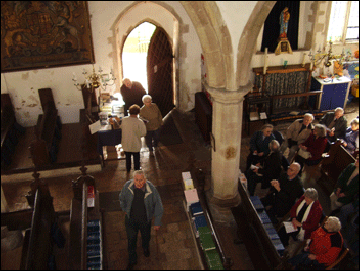
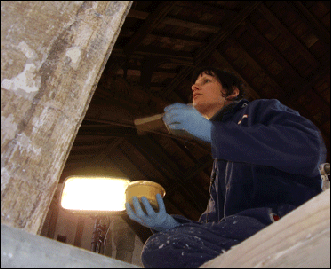
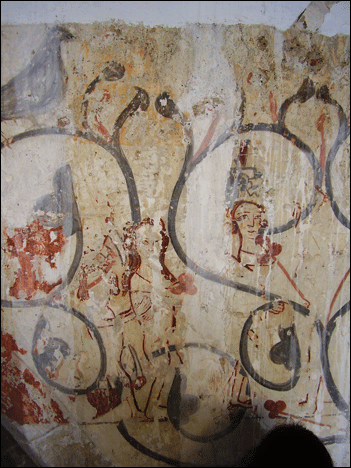
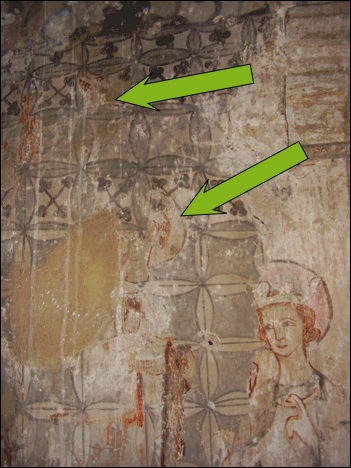
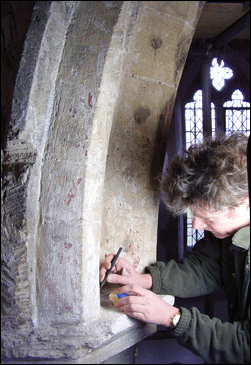
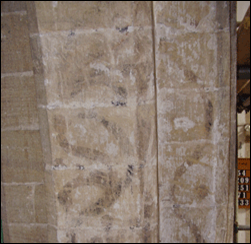

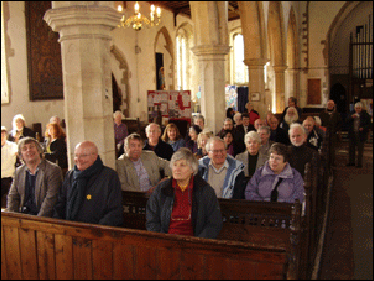
Tuesday 10th March—the final cleaning of many areas of the wall paintings has begun in earnest. Despite being near the end of the project, the paintings still have a few surprises in store for use. On some of the piers of the north arcade we were aware that there were early life sized paintings of individual figures. When we arrived at the church only one figure was clearly visible. The other two were so faint that they only showed themselves in certain light conditions. As the light changed throughout the day they would fade in and out of focus—like ghosts emerging from the stone. Now the piers have been cleaned the figures have emerged once again from the stonework. They are still faint, and details are difficult to make out, but they are once again visible.
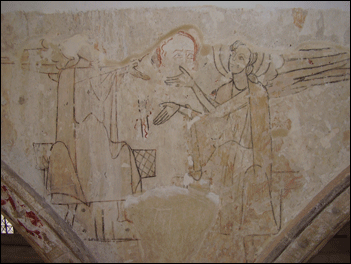
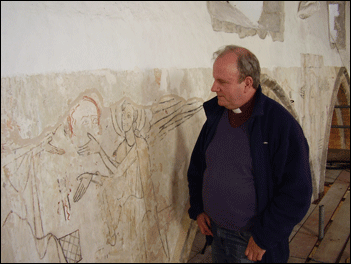
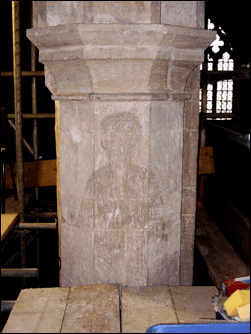
Thursday 12th March—whilst cleaning the pillars that separate the nave from the north aisle the conservation team have discovered another ghostly figure on one of the pillars. The figure is very badly damaged and very little can be made out. However, the figure is looking north, into the north aisle, and would seem to support the theory that the scheme did once continue in the aisle. A very last minute discovery and we can do little more than clean it and record it.
Friday 13th March—It’s time to say goodbye to Mark, Bianca and Doug from the Perry Lithgow partnership as the physical conservation process reaches its end. The team have been on site for five weeks—some of the coldest weeks on recent record—and have carried out an excellent job. The last day is spent in final cleaning and toning in of repairs whilst Mark, as conservation director, carries out a full photographic survey of the wall paintings. These images, along with all the many hundreds of other taken during the conservation process, will be incorporated into a final report. The report will be copied to all of the funding bodies as well as being lodged with the parish and expert organisations such as the Courtauld Institute.
The team have also received a great deal of support and encouragement from the parish, have welcomed many hundreds of visitors to the church, and will be sadly missed by everyone involved. A big thank-you to everyone who has been involved.
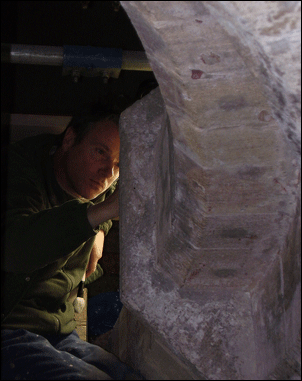
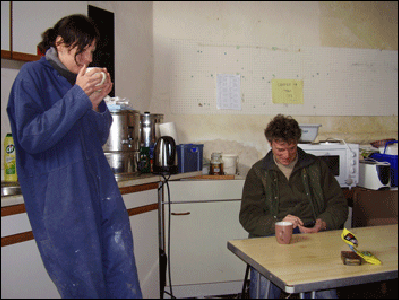
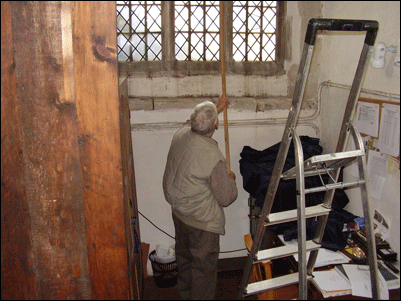
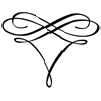
Left: Visitors arriving at the church for the third of our lunchtime lectures. These events became increasingly popular as members of the public became increasingly interested in the practical process of conservation.
Right: The upper section of the main pier in the north arcade clearly showed the damage caused by the historical leaks in the roof. The limewash located above the paintings has run across the surface leaving unsightly white stains - and washing away medieval pigment.
Right: St Edmund sitting on the left hand of the enthroned Virgin and child - most of which has been lost.
Arrow ‘A’ shows the position of the head of the Christ child, of which only one side of the halo can now be seen. Arrow ‘B’ marks the head of the Virgin, Her curled red hair can be seen outlining the space where her face once was.
A
B
Right: one of the full length figures on the piers of the north arcade. Prior to cleaning this figure was only visible in the early morning and late evening light- earning him the title of the Lakenheath ghost. After cleaning he was visible all through the day.
Below: the Rev. Robert Leach, then Rector of St Mary’s, finally gets the chance to meet the 13th century angels face to face having previously only been able to admire them from the ground.
Below: once the conservation team had left it was time for the parish to begin the final clean up.